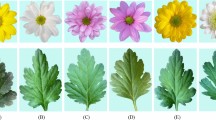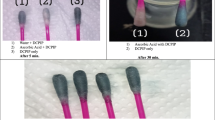Abstract
Ocimum basilicum, a member of the family Lamiaceae, is a rich source of polyphenolics that have antioxidant properties. The present study describes the development and application of an online HPLC-coupled acidic potassium permanganate chemiluminescence assay for the qualitative and quantitative assessment of antioxidants in three cultivars of O. basilicum grown under greenhouse conditions. The chemiluminescence based assay was found to be a sensitive and efficient method for assessment of total and individual compound antioxidant potential. Leaves, flowers and roots were found to be rich reserves of the antioxidant compounds which showed intense chemiluminescence signals. The polyphenolics such as rosmarinic, chicoric, caffeic, p-coumaric, m-coumaric and ferulic acids showed antioxidant activity. Further, rosmarinic acid was found to be the major antioxidant component in water-ethanol extracts. The highest levels of rosmarinic acid was found in the leaves and roots of cultivars “holy green” (14.37; 11.52 mM/100 g DW respectively) followed by “red rubin” (10.02; 10.75 mM/100 g DW respectively) and “subja” (6.59; 4.97 mM/100 g DW respectively). The sensitivity, efficiency and ease of use of the chemiluminescence based assay should now be considered for its use as a primary method for the identification and quantification of antioxidants in plant extracts.




Similar content being viewed by others
References
Ben Farhat M, Chaouch-Hamada R, Sotomayor J, Landoulsi A, Jordán M (2015) Antioxidant properties and evaluation of phytochemical composition of Salvia verbenaca L. extracts at different developmental stages. Plant Foods Hum Nutr 70(1):15–20. doi:10.1007/s11130-015-0466-9
Bellomarino SA, Conlan XA, Parker RM, Barnett NW, Adams MJ (2009) Geographical classification of some Australian wines by discriminant analysis using HPLC with UV and chemiluminescence detection. Talanta 80(2):833–838. doi:10.1016/j.talanta.2009.08.001
Malejko J, Nalewajko-Sieliwoniuk E, Nazaruk J, Sinilo J, Kojlo A (2014) Determination of the total polyphenolic content in Cirsium palustre (L.) leaves extracts with manganese(IV) chemiluminescence detection. Food Chem 152:155–161. doi:10.1016/j.foodchem.2013.11.138
McDermott GP, Conlan XA, Noonan LK, Costin JW, Mnatsakanyan M, Shalliker RA, Barnett NW, Francis PS (2011) Screening for antioxidants in complex matrices using high performance liquid chromatography with acidic potassium permanganate chemiluminescence detection. Anal Chim Acta 684(1–2):134–141. doi:10.1016/j.aca.2010.10.046
Del Bano MJ, Lorente J, Castillo J, Benavente-Garcia O, del Rio JA, Ortuno A, Quirin KW, Gerard D (2003) Phenolic diterpenes, flavones, and rosmarinic acid distribution during the development of leaves, flowers, stems, and roots of Rosmarinus officinalis. Antioxidant activity. J Agric Food Chem 51(15):4247–4253. doi:10.1021/jf0300745
Koşar M, Göger F, Hüsnü Can Başer K (2011) In vitro antioxidant properties and phenolic composition of Salvia halophila Hedge from Turkey. Food Chem 129(2):374–379. doi:10.1016/j.foodchem.2011.04.086
Damasius J, Venskutonis PR, Kaskoniene V, Maruska A (2014) Fast screening of the main phenolic acids with antioxidant properties in common spices using on-line HPLC/UV/DPPH radical scavenging assay. Anal Methods 6(8):2774–2779. doi:10.1039/c3ay41703d
Javanmardi J, Stushnoff C, Locke E, Vivanco JM (2003) Antioxidant activity and total phenolic content of Iranian Ocimum accessions. Food Chem 83(4):547–550. doi:10.1016/s0308-8146(03)00151-1
Erdemoglu N, Turan NN, Cakici I, Sener B, Aydin A (2006) Antioxidant activities of some Lamiaceae plant extracts. Phytother Res 20(1):9–13. doi:10.1002/ptr.1816
Gulcin I, Elmastas M, Aboul-Enein HY (2007) Determination of antioxidant and radical scavenging activity of basil (Ocimum basilicum L. family Lamiaceae) assayed by different methodologies. Phytother Res 21(4):354–361. doi:10.1002/ptr.2069
Javanmardi J, Khalighi A, Kashi A, Bais HP, Vivanco JM (2002) Chemical characterization of basil (Ocimum basilicum L.) found in local accessions and used in traditional medicines in Iran. J Agric Food Chem 50(21):5878–5883
Makri O, Kintzios S (2008) Ocimum sp. (basil): botany, cultivation, pharmaceutical properties, and biotechnology. J Herbs Spices Med Plants 13(3):123–150
Jayawardena N, Watawana MI, Waisundara VY (2015) Evaluation of the total antioxidant capacity, polyphenol contents and starch hydrolase inhibitory activity of ten edible plants in an in vitro model of digestion. Plant Foods Hum Nutr 70(1):71–76. doi:10.1007/s11130-014-0463-4
Karadag A, Ozcelik B, Saner S (2009) Review of methods to determine antioxidant capacities. Food Anal Method 2(1):41–60. doi:10.1007/s12161-008-9067-7
Mnatsakanyan M, Goodie TA, Conlan XA, Francis PS, McDermott GP, Barnett NW, Shock D, Gritti F, Guiochon G, Shalliker RA (2010) High performance liquid chromatography with two simultaneous on-line antioxidant assays: evaluation and comparison of espresso coffees. Talanta 81(3):837–842. doi:10.1016/j.talanta.2010.01.024
Niederländer HAG, van Beek TA, Bartasiute A, Koleva II (2008) Antioxidant activity assays on-line with liquid chromatography. J Chromatogr A 1210(2):121–134. doi:10.1016/j.chroma.2008.09.061
Francis PS, Costin JW, Conlan XA, Bellomarino SA, Barnett JA, Barnett NW (2010) A rapid antioxidant assay based on acidic potassium permanganate chemiluminescence. Food Chem 122(3):926–929. doi:10.1016/j.foodchem.2010.02.050
Conlan XA, Stupka N, McDermott GP, Barnett NW, Francis PS (2010) Correlation between acidic potassium permanganate chemiluminescence and in vitro cell culture assay: physiologically meaningful antioxidant activity. Anal Methods 2(2):171–173. doi:10.1039/b9ay00242a
Srivastava S, Cahill DM, Conlan XA, Adholeya A (2014) A novel in vitro whole plant system for analysis of polyphenolics and their antioxidant potential in cultivars of Ocimum basilicum. J Agric Food Chem 62(41):10064–10075. doi:10.1021/jf502709e
Costin JW, Barnett NW, Lewis SW, McGillivery DJ (2003) Monitoring the total phenolic/antioxidant levels in wine using flow injection analysis with acidic potassium permanganate chemiluminescence detection. Anal Chim Acta 499(1–2):47–56. doi:10.1016/s0003-2670(03)00551-8
Adcock JL, Francis PS, Barnett NW (2007) Acidic potassium permanganate as a chemiluminescence reagent-a review. Anal Chim Acta 601(1):36–67. doi:10.1016/j.aca.2007.08.027
Wang H, Provan GJ, Helliwell K (2004) Determination of rosmarinic acid and caffeic acid in aromatic herbs by HPLC. Food Chem 87(2):307–311. doi:10.1016/j.foodchem.2003.12.029
Lugato D, Simo MJ, Garcia R, Mansur E, Pacheco G (2014) Determination of antioxidant activity and phenolic content of extracts from in vivo plants and in vitro materials of Passiflora alata Curtis. Plant Cell Tiss Organ Cult 118(2):339–346. doi:10.1007/s11240-014-0486-4
Popovic BM, Stajner D, Slavko K, Sandra B (2012) Antioxidant capacity of cornelian cherry (Cornus mas L.) - comparison between permanganate reducing antioxidant capacity and other antioxidant methods. Food Chem 134(2):734–741. doi:10.1016/j.foodchem.2012.02.170
Dorman HJ, Bachmayer O, Kosar M, Hiltunen R (2004) Antioxidant properties of aqueous extracts from selected Lamiaceae species grown in Turkey. J Agric Food Chem 52(4):762–770. doi:10.1021/jf034908v
Jayasinghe C, Gotoh N, Aoki T, Wada S (2003) Phenolics composition and antioxidant activity of sweet basil (Ocimum basilicum L.). J Agric Food Chem 51(15):4442–4449. doi:10.1021/jf034269o
Sgherri C, Cecconami S, Pinzino C, Navari-Izzo F, Izzo R (2010) Levels of antioxidants and nutraceuticals in basil grown in hydroponics and soil. Food Chem 123(2):416–422. doi:10.1016/j.foodchem.2010.04.058
Kwee EM, Niemeyer ED (2011) Variations in phenolic composition and antioxidant properties among 15 basil (Ocimum basilicum L.) cultivars. Food Chem 128(4):1044–1050. doi:10.1016/j.foodchem.2011.04.011
McDermott GP, Noonan LK, Mnatsakanyan M, Shalliker RA, Conlan XA, Barnett NW, Francis PS (2010) High-performance liquid chromatography with post-column 2,2′-diphenyl-1-picrylhydrazyl radical scavenging assay: methodological considerations and application to complex samples. Anal Chim Acta 675(1):76–82. doi:10.1016/j.aca.2010.06.041
Acknowledgments
We duly acknowledge the assistance from Mr. Shailendra Kumar for managing the greenhouse experiments at TERI. Infrastructure support provided by TERI, India and Deakin University, Australia is also acknowledged. Deakin University provided a post graduate scholarship to SS.
Author information
Authors and Affiliations
Corresponding author
Ethics declarations
Conflict of Interest
The authors declare that there is no conflict of interest.
Rights and permissions
About this article
Cite this article
Srivastava, S., Adholeya, A., Conlan, X.A. et al. Acidic Potassium Permanganate Chemiluminescence for the Determination of Antioxidant Potential in Three Cultivars of Ocimum basilicum . Plant Foods Hum Nutr 71, 72–80 (2016). https://doi.org/10.1007/s11130-016-0527-8
Published:
Issue Date:
DOI: https://doi.org/10.1007/s11130-016-0527-8




